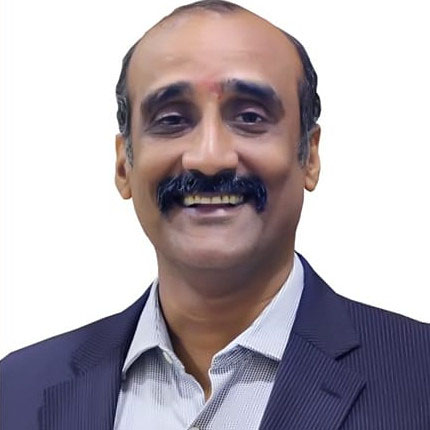
Sify Technologies’ CFO, M P Vijay Kumar, talks about outcome based pricing model which involves deep understanding of customer’s business risks and how the organisation is getting reoriented from this perspective.r

Recognised as one of the 100 most influential CFOs in India by CIMA, M P Vijay Kumar’s contribution to the field of Finance has not gone unnoticed. He has received many awards, one of them being a national award for contribution to Financial Accounting by Capital Foundation Society. A chartered accountant, cost accountant and company secretary by profession, he joined Sify, prominent integrated ICT Solutions and Services companies in India, in 2007 as its CFO and serves as Director on the Boards of Sify Technologies Singapore Pte Limited, National Internet Exchange of India (NIXI) and Thejo Engineering Limited. In his eleven years with Sify, apart from playing the traditional CFO’s role, he has also been part of the executive team of the organisation involved in strategizing its long term growth. In this freewheeling conversation with Smart CEO, he talks about Sify’s transformation, his role and the company’s growth plans going forward.
Do take me through how the company has evolved over the last 12 years, highlighting some significant milestones?
The journey from 2007 to 2012 was about shrinking consumer business and building enterprise business. When we came on board, Sify was a B2C company, a strong brand. However, we decided to give up B2C and take B2B route as that with the kind of evolution happening in the telecom space. We took the DNA of the organisation which was around networking, shared infrastructure management and operating data centers and started building infrastructure around that. Today, we are among the largest B2B enterprise networking company and data centre operators.
In 2012, we came back to black, for the first time in history of the organisation. After 2012, we took a fresh look at how to grow and that’s when we started adding services like managed services on network, on data center and on cloud. While cloud is popular, even before cloud was heard of, Sify had an equivalent of a public cloud. We started building services on it and have had a successful journey engagement with enterprise customers and to some extent central Government sponsored projects.
Today, we are a company with a revenue of Rs.2,100 crore, which was built since 2007; with Rs.300 crore plus EBIDTA and Rs. 100 crore plus net profit. We have offered 6 years of dividend in a row and our challenge now is to maintain this growth rate.
We are working towards moving most of our customers to outcome based pricing model. This involves consultative arrangement with customers with a need to understand their business and their growth plans and assess our ability to underwrite the risk of downfall.
Our aim is to be the digitalisation partner for all enterprises in their journey of digitalisation. Anything around digitalisation involves consumption of quality Internet, mainly a secured Internet. With Sify being a focussed enterprise telecom player, it is well positioned to address the customer around this.
From business model point, we are driving an important change, which is outcome-based pricing model. Pricing models have historically been input based or output based, which is the next level. We have gone one step further, which is outcome which the customer has derived by consuming our services. Today, we have one state power distribution company as our client and they consume network, data center and application. We charge them not based on what we are providing but what they are generating. We are working towards moving most of our customers to this model. This involves consultative arrangement with customers with a need to understand their business and their growth plans and assess our ability to underwrite the risk of downfall.
When we look at models like these, it involves a deep understanding of the customer business risk and hence, we have shifted to a vertical based go-to market strategy. We have vertical understanding capabilities and understand risk associated with customer business, their own financial model and how their business model works. As the risk function of the company resides with the CFO, we get actively engaged in this process.
Our verticals include BFSI, manufacturing, ecommerce, media, and healthcare. Majority of revenue comes from BFSI, followed by manufacturing and retail.
How has your role evolved during this period?
The first 5 years was the toughest period, that was when we were in red and we were setting things right. I was from an investment banking background and had to understand the IT business and culture of working in an IT company. That was the first phase where I was largely working towards bringing things back to normal.
The second phase was to support the growth and taking some calculated risks.
The third phase is to execute new models like outcome based pricing model and partnering with customers in terms of their digitalisation journey.

You were teaching aspiring CA students. How did your role as a teacher help you in your role as a CFO?
Teaching was all about connecting with the young minds (in the age of 20 to 23 years). The ability to connect with the next gen helped me work in the organisation which had a young population.
I was teaching Finance and it gave me deeper conceptual understand. Lots of changes were happening in the financial aspects and my academic connect helped me understand them better.
There was a continuous need to stay updated. And teaching helped as I was dealing with students who were in the verge of becoming CAs and at the same time working in large firms, exposed to large clients.
Sify operates in a completely b2b space where there is strong competition. What differentiates you from the rest of the players?
Sify has a unique position which is both positive and negative. The positive part is that it is the only converged services player that can offer all the services which a customer wants – be it on the network, datacentre or cloud. But, for each of the individual businesses, we had to compete with large organisations that were focussed in some of the services. For example, in telecom networking business we had to compete with Airtel, Tata and BSNL whose enterprise service business is a part of overall telecom services. We had to compete with individual business segment of large players. But our agility differentiated us from them.
As far as Data centers go, we have focussed players now. The cloud and managed services is a large space and our unique positioning is our ability to operate hybrid services.
Majority of our revenue comes from telecom followed by data center.
Where do you see the organisation headed? And your role in leading the organisation?
We are company focussed on the Indian market. We expect the next 3 years to 5 years to be a reasonably good growth period and we have built enough skill sets in terms of reorienting the organisation from vertical perspective.
We would like to bring in people for application related services. We had certain skill set gaps like application migration for industry standard application. We have invested in this, we are set to derive the benefit of market growth and given our size we should be able to grow at a rate higher than the industry growth rate.
We are also evaluating engaging with the startup ecosystem to bring in technology.

- Views on CEO and CFO working together to improve the quality of planning and forecasting
For a startup, the roles are best done by the founder. Once the organisation evolves, the Finance function will fall in place. I would prefer the organisation to be nimble. There has to be a minimal need for compliance structures. Entrepreneurs should focus on getting their main objective in place. It requires a lot of focus and energy and not get distracted with compliance and accounting.
Once you receive external funding, you should have a structure and process in place. Suppose it’s a startup working around building workflows and processes, obviously the Finance person has to contribute to the thinking process.
- Importance of integration amongst the leaders of organisations
Most important integration is on the strategic outlook. Once agreed on something, no second thoughts, just execute. There should be no disconnect in the strategic direction of the organisation. When it comes to each leader’s roles, it is best left to them to have their own execution and monitoring process with a good process for exchanging information. Have a good review mechanism so that there is exchange of information.